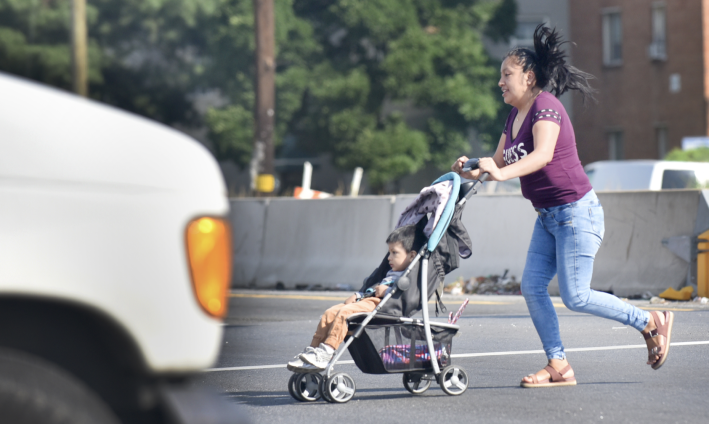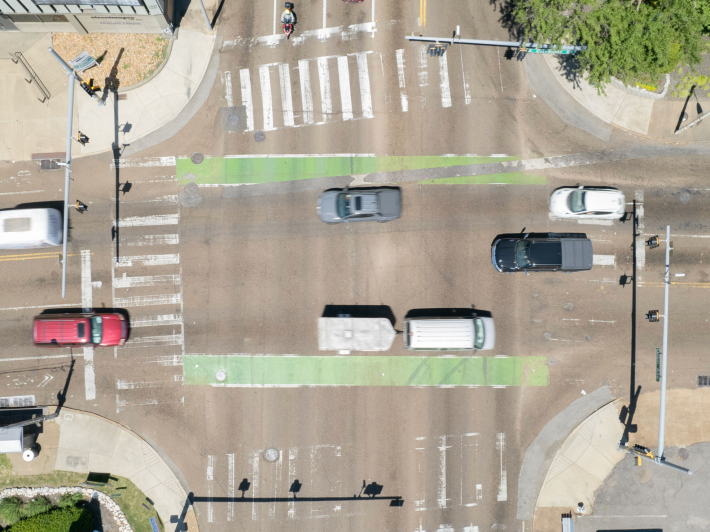America's pedestrian death crisis has been linked to bigger cars, more driving and pandemic anxieties, but it all starts with bad design, a new report shows.
Smart Growth America's annual, "Dangerous by Design," the latest installment of a decade-long series, discovered that, even as driving dropped during the pandemic, pedestrian-death rates rose alarmingly — and appear to be getting worse — largely because of the legacy of poor road designs in many states that emphasize moving cars quickly at the expense of street users outside of vehicles.

"Sixty percent of all 2020 deaths occurred on non-interstate arterial highways," said Beth Osborne, director of Transportation for America. "If you only look at urban areas, it's over 70 percent of the fatalities occur here," yet "these arterials make up only about 15 percent of our roadways."
The concentration of dangers on multi-lane arterial roads presents an opportunity, however: "We can tackle 15 percent of the roads, and if we do that, we could have an incredible shift in these numbers in a pretty short period of time. We could that be back here in five or 10 years, with incredibly different results," Osborne said.

The report, which used data from the National Highway Traffic Safety Administration, found that:
- Pedestrian fatalities rose 4.7 percent nationally in 2020 over 2019, to 6,529 people, or almost 18 per day, even with disrupted travel because of the pandemic.
- A "jaw-dropping" 7,485 people walking were struck and killed in 2021, according to preliminary data — a rate between 11 and 13 percent higher than 2020, "the highest number in 40 years and one of the biggest single-year jumps in decades."
- 67 of the 100 largest metro areas and 33 states saw pedestrian death rates rise compared to the four years before the pandemic.
- Fatality rates for all road users rose in 81 of the 100 largest metropolitan areas. It fell — but only marginally — in 19.
- Only four states — New York, North Dakota, Massachusetts and Montana, plus the District of Columbia — showed a drop in fatalities during the past five years compared with the five years before.
The jump in pedestrian fatalities in the past two years belies previous thinking that less driving would lead to fewer such deaths, Osborne said — and points to real deficiencies in the American approach to traffic engineering.
"Our firmly held beliefs in the past were not true and, therefore, some of the myths that we still hold on to should be revisited," Osborne said. "One of the biggest myths was that these deaths were inevitable as driving increased, we would see fatalities increase, and as driving decreased, we would also see deaths decrease. [But] we saw driving decrease and deaths increased by shocking amounts. So there is something here that needs attention, especially considering that nearly every other peer country started with a better safety record than the United States, and then saw pedestrian fatalities and overall fatalities decrease during the pandemic."
Of the 20 states with the highest pedestrian-death rates per 100,000 people in the past five years, most are in the Sun Belt, where car-centric metro areas built after 1960 prioritized high-speed vehicle travel. Such cities and towns have many arterials, defined as roads with high speeds; few marked, signalized cross walks, and many destinations such as stores along them, leading to more deadly interactions between pedestrians and drivers. For example, check out the intersection design in the image below: The curved corners were installed to allow drivers to take turns at reckless speeds:

On arterials, crosswalks can be located as much as 0.4 miles apart, potentially requiring a 10-minute round trip to reach a destination that's directly across the street — a huge burden for a walker who might be carrying groceries, using an assisted-mobility device, or pushing a stroller. Sidewalks are often an afterthought, according to the report.

Thus, the 10 states that had the biggest gains in their rates of pedestrian fatalities during that period were, in order, New Mexico, Florida, Arizona, Delaware, Louisiana, Mississippi, Nevada, California, Alabama, and Texas.
And the same populations made vulnerable by other American policy failures also faced the most likelihood of being killed on poorly designed roads: Black Americans are being killed at double and Native Americans at almost three times the rate of white Americans.
"Older adults and people walking in low-income neighborhoods were also struck and killed at much higher rates than other populations in 2020, as with past years. The conditions people face when they want to walk or bike — whether to work or for recreation — are not the same for all Americans. Low-income communities are significantly less likely to have access to parks and other opportunities for safe recreational walking and are less likely to have sidewalks, marked crosswalks, and street design to support safer, slower speeds," the report states.
The report recommends a variety of engineering and other measures that could help the federal government, states and municipalities lower pedestrian death rates:
- Better data: The national Fatality Analysis Reporting System has a 10 to 16 month reporting lag, making it difficult to evaluate current or even recent conditions.
- Better design standards: The Federal Highway Administration should update the Manual on Uniform Traffic Control Devices to emphasize safety over vehicle speed.
- Better use of federal funding: The U.S. Department of Transportation should spend the $200 billion in discretionary competitive grants from the 2021 Infrastructure Investment and Jobs Act on safety projects. Congress should fully fund all programs for combating pedestrian fatalities, such as the Healthy Streets Program and the Active Transportation Infrastructure Investment Program .
- Better use of existing rules: The 2021 infrastructure law authorized cities to use safer street design guidelines from the National Association of City Transportation Officials when using federal money, even when states prohibit it through their own design regulation. They should do so.
Osborne said that, in order to prevent more pedestrian fatalities, the United States must change its approach to traffic engineering systemically. "While there are plenty of examples of successful safety improvements on specific corridors," she stressed, "this approach is failing to make a meaningful dent in the overall fatality rates, because it's not enough to fix one corridor we have to fix every corridor. Safety has to be the default."
Obviously, the U.S. has other factors that are increasing the pedestrian death count, too, including the gargantuan size of our vehicles, structural racism in the transport system, and speeding and distracted driving.






